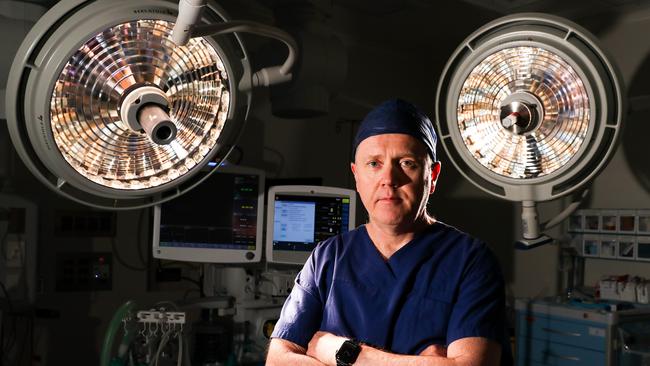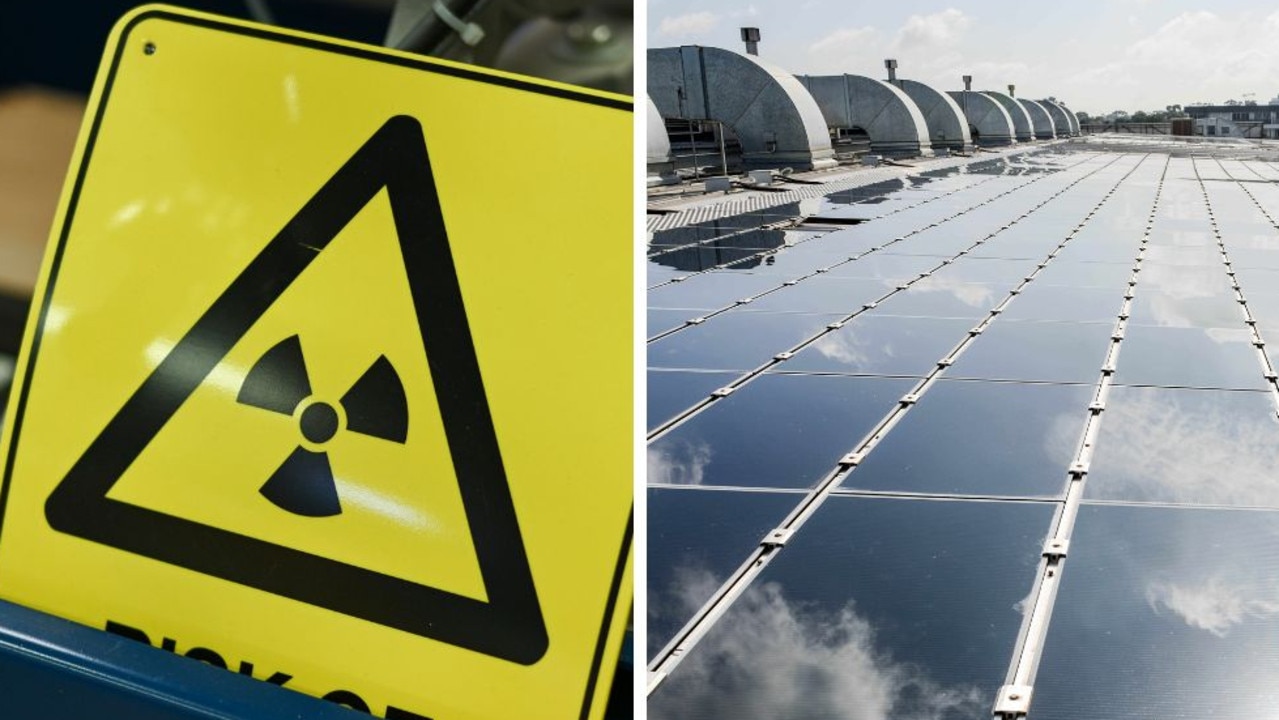Coronavirus: ‘Crony experts should be axed’, says doctor
Health workers have been put at risk by a failure to toughen recommendations on PPE use.

Tens of thousands of healthcare workers have been put at risk by the failure of the nation’s top infection control advisers to toughen recommendations on the use of protective equipment and acknowledge the airborne spread of coronavirus, a senior doctors’ representative has warned.
The head of the Australian Medical Association in Western Australia, Andrew Miller, said the high rate of healthcare worker infections in Melbourne was a “national disaster” that had largely contributed to the city’s harsh lockdown and was preventing the easing of restrictions.
There have been almost 3600 healthcare workers infected in Melbourne’s second wave of COVID-19, with thousands more furloughed, forcing the closure of wards and the movement of patients off site at one hospital.
Despite the explosion in the number of infected healthcare workers, the federal chief advisers on infection control failed to upgrade their guidelines to recommend the use of respirator masks in all situations when dealing with suspected or confirmed coronavirus cases.
The current guidelines stipulate that only a surgical mask is required unless a healthcare worker is performing an aerosol-generating procedure such as taking a throat swab, or in situations where there are a high number of COVID-19 patients or the possibility that a patient will exhibit “challenging behaviour”.
Dr Miller, an anaesthetist, is now calling for the resignation of the chair of the federal Infection Control Expert Group, infectious diseases physician and microbiologist Lyn Gilbert. Dr Miller attacked the group as being made up of “largely cronies”.
“We have this patently ridiculous attitude towards healthcare worker safety from the Infection Control Expert Group, which is a group of boffins who don’t do our jobs, who were in charge before he disastrous Melbourne outbreak, and inexplicably are still in charge,” Dr Miller said.
“This committee is largely cronies, people who are very well known to each other, whose careers are interdependent, and they suffer from groupthink, lack of diversity and demonstrated failure.
“Right now the brutal fact of it is they’ve failed us. The whole committee needs to be revamped and we need to start taking PPE seriously or Melbourne won’t be the only place that ends up locked down and this won’t be the last lockdown for Melbourne.”
Professor Gilbert declined to respond. Acting Chief Medical Officer Paul Kelly said he had “full confidence” in Professor Gilbert and all members of the group.
“They have an unwavering commitment to evidence-based decision-making, which has evolved based on the most up-to-date evidence,” Professor Kelly said.
Since the beginning of the pandemic, 3599 healthcare workers — including in hospitals, aged care, GP clinics and allied health — have been infected in Victoria.
“It’s a national disaster,” Dr Miller said. “We don’t know yet how many died or ended up in ICU because they haven’t released that data. It’s caused the lockdown, there’s no doubt about it.”
The Royal Melbourne Hospital was forced to close four wards and move some patients off site in August when 139 healthcare workers were infected. St Vincent’s Hospital has had 115 COVID-19 cases in healthcare workers, and another four Melbourne hospitals including the Northern, Sunshine and Footscray, have had between 50 and 100 cases each.
Another recent cluster of cases at Box Hill hospital has accounted for a significant proportion of recent daily case numbers.
The Royal Melbourne said in a statement it had been “in line with, and in some cases above” DHHS requirements on PPE. “The safety of our staff and patients has been, and continues to be, our highest priority,” the hospital said.
St Vincent’s said its staff were “were required to wear N95 respirators when caring for patients who have tested positive or are suspected of having COVID-19”.
The Victorian health department in July strengthened its guidelines around the circumstances in which P2 or N95 respirator masks should be worn, but doctors say they are still inadequate.
The guidelines now mandate that P2 or N95 masks be worn when frequent or prolonged episodes of care are provided to COVID-19 positive patients, in “uncontrolled settings” where suspected or confirmed coronavirus patients are cohorted, and where there is a risk of unplanned aerosol generating procedures or behaviours.
Aerosol generating procedures include intubation, ventilation or sectioning of the airways.
Melbourne infectious diseases physician Michelle Ananda-Rajah described the PPE that many doctors and nurses had been given in Melbourne hospitals as “budget standard”.
“When you’re seeing healthcare outbreaks occurring amidst plummeting community transmission there should be alarm bells ringing,” she said.
“The national guidelines have chopped and changed. Policies have been reactive rather than precautionary. We have reacted to these crises rather than preventing them by giving us the highest level of PPE.”
Dr Ananda-Rajah also criticised a “command and control” culture in many hospitals in which healthcare workers have been “bullied and censored” and had their concerns at inadequate PPE dismissed.
“Overlying all the themes really was a failure of leadership,” she said. “All of these people in power, the healthcare workers feel that they have failed them.”
The US Centers for Disease Control and Prevention recommends the use of respirator masks for any care of suspected or confirmed COVID-19 cases, as does the European Centre for Disease Prevention and Control.
Asian countries are much stricter on the use of PPE, with healthcare workers in Singapore, Taiwan and South Korea kitted out in head-to-toe suits and tight goggles with no skin or hair exposed. There have been very few infections in healthcare workers in those countries.
Melbourne doctor Benjamin Veness, a psychiatry registrar, said fit-testing of P2 and N95 respirators had also been woefully inadequate.
“Not only have we done a poor job or providing the requisite PPE, but we haven’t done our utmost to make sure it fits and that people are trained in how to use it,” Dr Veness said.
Dr Veness called for national guidelines to be brought into line with those of the US and European CDCs, both of which acknowledge airborne spread of COVID-19 through normal physiological activity like speaking.
Dr Veness said there had been “a false assumption made that only particular types of interventions lead to the generation of aerosols and only in those circumstances were N95s provided”.
The federal Health Department, on behalf of the ICEG, said it had “consistently acknowledged the potential for transmission of SARS-CoV-2 via aerosols in specific circumstances”.
“The role of transmission via aerosols in real-life transmission of SARS-CoV-2 is unclear,” the department said.
“ICEG notes recent report of health care worker infections acquired in the workplace in the setting of prolonged, close patient contact. It remains unclear whether this reflects enhanced infection potential via predominant modes of transmission such as increased dispersal of infectious droplets and heavy environmental contamination, or aerosolisation.”
International statistics on healthcare worker infections are not available, but the level of infection in Victorian healthcare workers is relatively high by world standards. A recent paper published in The Lancet found that the prevalence of COVID-19 in the US was 2747 cases per 100,000 frontline healthcare workers compared with 242 cases per 100 000 people in the general community.
There are 119,813 doctors and nurses registered in Victoria.




To join the conversation, please log in. Don't have an account? Register
Join the conversation, you are commenting as Logout